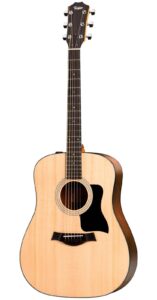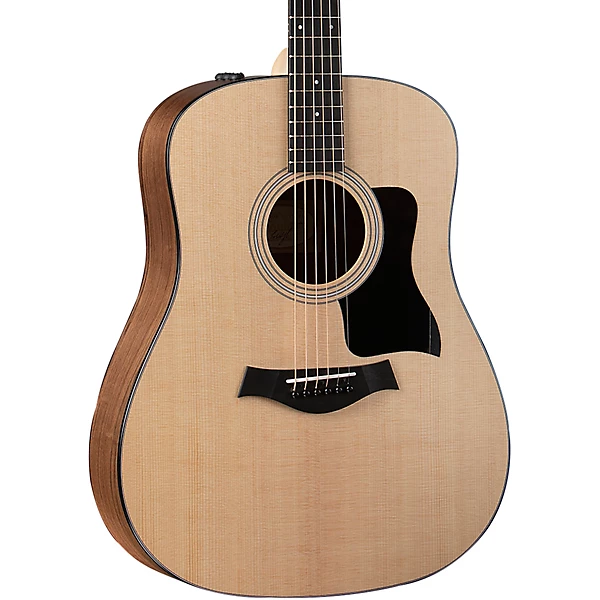Finding the perfect acoustic guitar feels like searching for a needle in a haystack, especially when you’re eyeing premium brands like Taylor. The Taylor 110e stands out in the crowded mid-range market, promising professional-grade sound without breaking the bank. This acoustic-electric workhorse has caught the attention of both beginners and seasoned players, but does it live up to the Taylor name? Whether you’re considering your first serious guitar investment or adding to your collection, the 110e deserves a closer look. Let’s explore what makes this Taylor 110e acoustic guitar a compelling choice in 2024, from its rich tone to its stage-ready electronics.
First Impressions and Build Quality
When you first lay hands on the Taylor 110e, you’re greeted with a guitar that embodies both simplicity and sophistication. The instrument arrives in a lightweight gig bag, setting the stage for what Taylor positions as a versatile performer’s companion.
Unboxing Experience
Opening the package reveals a thoughtfully designed dreadnought that strikes a balance between traditional esthetics and modern functionality. The non-cutaway design immediately catches your eye, suggesting Taylor’s commitment to preserving classical guitar architecture. While the unboxing experience is straightforward, it’s the guitar’s presence that commands attention rather than elaborate packaging.
Construction Materials
The Taylor 110e boasts a carefully selected combination of tonewoods:
- Solid Sitka Spruce Top: Delivers broad dynamic range and versatility
- Layered Walnut Back and Sides: Provides warm esthetic appeal and balanced tone
- Hard Rock Maple Neck: Ensures stability and smooth playability
- African Ebony Fingerboard: Adds premium touch to playability
The guitar’s construction follows Taylor’s Standard II Bracing with Forward Shift Pattern, engineered to enhance sustain and resonance. This thoughtful design approach makes the 110e particularly accommodating for various playing styles, from strumming to fingerpicking.

Finish and Esthetics
The esthetic presentation of the 110e reflects Taylor’s approach to accessible premium instruments. You’ll notice the subtle matte finish that adorns both the body and neck. The finish work presents some interesting contrasts in quality – while the overall appearance is pleasing, some details reveal the guitar’s price-point compromises. The soundhole features minimal ornamentation, keeping with the instrument’s straightforward design philosophy.
The rich brown hues of the layered walnut back and sides lend a natural warmth to the guitar’s appearance. However, you might notice that the finish application is relatively thin, which some players appreciate for its potential tonal benefits, while others might find it somewhat understated.
What’s particularly noteworthy is how the 110e manages to maintain a professional appearance despite its position as an entry-level Taylor. The 1-11/16″ (42.8mm) nut width contributes to a comfortable playing experience, while the overall construction reflects Taylor’s commitment to providing value without compromising essential quality elements.
Sound Performance Analysis
The sonic character of the Taylor 110e reveals itself the moment you strike your first chord. Its bright, piano-like bass notes create an almost chorus-like sheen that sets it apart from typical guitars in its class.
Acoustic Tone Characteristics
The solid spruce top serves as the heart of the 110e’s voice, delivering bold, assertive acoustic sound with remarkable projection. You’ll notice a punchy response complemented by warm midrange and crisp trebles, creating a balanced tonal palette. What’s particularly impressive is the guitar’s response to different playing intensities – light touches produce clear, articulate notes, while harder playing yields substantial volume without bass distortion.
Genre Versatility
The Taylor 110e proves to be remarkably adaptable across various musical styles. Its versatility shines through in multiple playing scenarios:
- Strumming and Flatpicking: The dreadnought body projects full, powerful sound
- Fingerpicking: Maintains clarity and definition between notes
- Bluegrass: Offers the punch and projection needed
- Contemporary Styles: Provides balanced tone for modern techniques
The guitar’s bracing system deserves special mention, as it allows consistent sound quality whether you’re playing soft fingerpicking passages or aggressive runs.
Recording Quality
The Expression System 2 (ES2) electronics elevate the 110e’s recording capabilities significantly. The system’s three uniquely positioned and individually calibrated pickup sensors capture the guitar’s dynamic range with remarkable accuracy. When plugged in, you’ll find the ES2 delivers a clean-sounding acoustic tone that’s particularly useful for live performances and recording sessions.
What truly sets this system apart is its positioning behind the saddle rather than underneath it, resulting in a broader dynamic range and more natural acoustic response. However, it’s worth noting that while the amplified tone is serviceable, you might need outboard EQ for perfect venue sound.
One of the most intriguing aspects of the Taylor 110e is how it matures over time. As the guitar ages, you’ll notice the development of a deeper and more robust sound, particularly in models made with quality tonewoods. This evolutionary characteristic makes the 110e not just a current investment but a guitar that promises to sound even better as the years pass.
Playability and Comfort
For passionate guitarists, comfort and playability often determine the difference between a good instrument and a great one. The Taylor 110e excels in this department, offering a playing experience that feels natural from the first chord.
Neck Profile and Action
The Taylor 110e features a hard rock maple neck with Taylor’s standard profile, designed for optimal hand positioning and smooth transitions. The neck’s satin varnish finish creates a smooth, fast-playing surface that doesn’t get sticky during extended sessions. What sets this guitar apart is its thoughtful construction that minimizes chording difficulty, making it particularly appealing if you’re transitioning from electric to acoustic.
String Spacing and Tension
Your fretting hand will appreciate the carefully calculated dimensions:
- Nut width: 1-11/16″ (42.8mm) for comfortable finger positioning
- Scale length: 25-1/2″ with 20 accessible frets
- Well-balanced string tension for easy playability
The string spacing proves especially beneficial when you’re working through complex chord progressions or intricate fingerpicking patterns. You’ll find that the neck-to-body relationship creates an ideal playing position, allowing your hands to work in harmony whether you’re seated or standing.
Playing Experience Across Styles
What truly distinguishes the Taylor 110e is its versatility across different playing styles. The guitar responds beautifully to both delicate fingerstyle pieces and aggressive strumming patterns, adapting to your playing dynamics with remarkable consistency. You’ll discover that the instrument feels more like an extension of your musical expression rather than a physical tool.
The dreadnought body, while substantial, maintains excellent balance and comfort during long playing sessions. This is particularly noticeable when you’re switching between sitting and standing positions during performance. The body’s proportions create an intimate feel despite its full-size dimensions, making it suitable for players of various builds.
One of the most practical aspects of the 110e is its maintenance-friendly nature. The durability of its construction means you’ll spend less time adjusting and more time playing. This accessibility in setup and maintenance ensures that the guitar’s excellent playability remains consistent over time, making it a reliable companion for both practice sessions and live performances.
Electronics and Amplified Sound
The heart of the Taylor 110e’s plugged-in performance lies in its sophisticated electronics, featuring the revolutionary Expression System 2 (ES2). This innovative system represents Taylor’s commitment to delivering authentic acoustic sound in amplified settings.
ES-2 System Overview
The ES2 system’s core innovation is its patented behind-the-saddle pickup design, featuring three uniquely positioned and individually calibrated pickup sensors. This strategic placement enables the system to capture a more dynamic range of acoustic sound than traditional undersaddle pickups. Working in harmony with Taylor’s custom-designed professional audio-grade preamp, the ES2 delivers exceptional amplified tone and responsiveness.
Live Performance Capabilities
When you’re performing live, you’ll appreciate the ES2’s versatility across different venues. Whether you’re running through a PA system, connecting to an acoustic amplifier, or recording directly into software, the system faithfully preserves your guitar’s natural voice. The automatic battery conservation feature adds practical value – the system remains off until you plug in a cable, helping preserve battery life for when you need it most.
Sound Shaping Options
The ES2 provides intuitive control over your amplified tone through three soft-touch knobs. Here’s how you can shape your sound:
- Bass and Treble Controls: Rotating past center adds emphasis, while counterclockwise turns reduce respective frequencies
- Volume Control: Works in conjunction with EQ settings for optimal output levels
- Phase Switch: Helps combat unwanted feedback in live situations
What makes the ES2 particularly impressive is its ability to react to subtle adjustments. When you increase both bass and treble beyond center, you’ll notice an automatic dipped midrange effect. Conversely, reducing both while raising volume creates a midrange boost. This flexibility allows you to dial in your perfect tone for any performance situation.
The system’s positioning behind the saddle, rather than underneath it, results in a broader dynamic range and more natural acoustic response. You’ll find this especially beneficial during recording sessions, where the ES2 captures the guitar’s nuances with remarkable clarity. The setup requires minimal post-production work, making it an excellent choice for both live performances and studio recordings.
While the amplified tone maintains professional quality, it’s worth noting that venue-specific adjustments might require additional outboard EQ for optimal sound. However, the three small rotary controls, featuring a thoughtful center-point bump design, make on-the-fly adjustments manageable even on dimly lit stages.
Value Proposition
Investing in a musical instrument requires careful consideration of both immediate satisfaction and long-term value. The Taylor 110e presents an intriguing proposition in the mid-range acoustic guitar market, balancing premium features with accessibility.
Price Point Analysis
At a new price point of $799, the Taylor 110e positions itself in an interesting sweet spot between entry-level and premium instruments. While this represents a significant investment, especially for beginners, you’re getting access to Taylor’s renowned craftsmanship at a fraction of their high-end models’ cost. The guitar’s Mexican manufacturing heritage contributes to its competitive pricing while maintaining impressive build quality standards.
What makes this price point particularly compelling is the inclusion of professional-grade features. You’re getting a solid Sitka spruce top, the sophisticated ES-2 electronics system, and Taylor’s renowned build quality, all while staying under the $1,000 mark.
Competition Comparison
When examining build quality metrics, the Taylor 110e demonstrates clear advantages over similarly priced competitors:
| Quality AspectTaylor 110eCompetition Average | ||
| [Materials Quality | 76/100](https://findmyguitar.com/compare/Taylor-110e-vs-Yamaha-FG830-comparison.php) | 66/100 |
| Quality Control | 70/100 | 55/100 |
| Overall Build | 74/100 | 62/100 |
The guitar’s performance metrics further reinforce its value proposition:
- Sound Quality Score: 85/100
- Versatility Rating: 85/100
- Tuning Stability: 70/100
Long-term Investment Perspective
Your investment in the Taylor 110e extends beyond immediate gratification. While Taylors typically depreciate faster than some other premium brands, this model offers several long-term advantages:
The guitar’s build quality suggests excellent durability, with the Mexican manufacturing process following similar standards to those used in premium instrument production. You’ll find that the instrument’s versatility across different playing styles provides lasting value, making it suitable for your evolving musical journey.
What’s particularly noteworthy is how the guitar matures over time. Like many well-crafted acoustics, the 110e’s tone tends to improve with age, developing more character and depth. This natural evolution adds another dimension to your investment, as the instrument’s voice continues to develop alongside your playing skills.
When considering the long-term value proposition, it’s worth noting that while the 110e may lack some of the ornate features found in higher-end models, it compensates by delivering excellence in the areas that matter most: playability, build quality, and sound. This focus on essential qualities over cosmetic embellishments ensures that your investment remains practical and valuable throughout your musical journey.

Conclusion
The Taylor 110e proves itself a remarkable achievement in guitar craftsmanship, striking an impressive balance between professional features and accessibility. Your $799 investment brings home Taylor’s signature quality, complete with the sophisticated ES2 electronics system and premium tonewoods that typically grace much pricier instruments.
This guitar shines brightest through its versatility – equally capable of handling delicate fingerpicking or aggressive strumming while maintaining exceptional clarity and projection. The Mexican-built 110e might lack some cosmetic flourishes of its premium siblings, but it delivers where it matters most: sound quality, playability, and construction.
Perhaps most compelling is how this guitar grows with you. The solid spruce top will develop a richer voice over time, while the thoughtful construction ensures years of reliable performance. Whether you’re stepping up from a starter guitar or adding to your collection, the Taylor 110e stands as a testament to what’s possible in a mid-range acoustic-electric guitar.
FAQs
What type of wood is used in the construction of the Taylor 110e?
The Taylor 110e features a solid Sitka spruce top, which is known for its ability to enhance the guitar’s warmth and projection, significantly influencing its overall sound quality.
Where is the Taylor 110e manufactured?
The Taylor 110e is produced with specific technical specifications that detail its manufacturing process.
Do Taylor guitars become more valuable over time?
Generally, Taylor guitars do not appreciate in value over time.
Which acoustic guitar is considered the best in the world?
While “the best” can vary based on personal preference and needs, notable models include the Cort Earth L60M for beginners, the Fender PO-220E for affordability, the Taylor Builder’s Edition 814ce for electro-acoustic needs, the Martin D-28 Modern Deluxe as a top dreadnought choice, and the Martin Inception GPCE for high-end options.
I recently purchased a Taylor 110e and am finding it difficult to play due to its string tension and fret buzz. What should I do?
It sounds like your Taylor 110e might benefit from a professional setup to adjust the action and possibly address the fret buzz. If the guitar still feels uncomfortable, you might consider restringing it with lighter gage strings, although this could slightly alter the sound quality that initially attracted you to the instrument. If these adjustments do not improve your playing experience, you might want to consider returning the guitar if that option is available.

